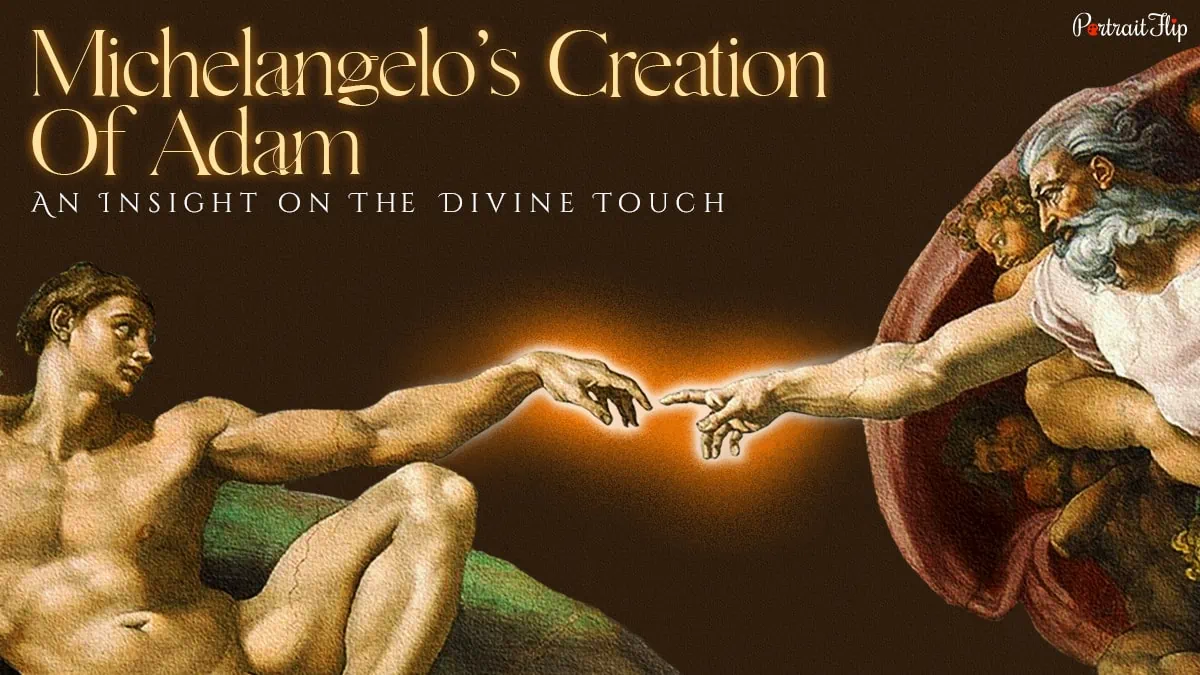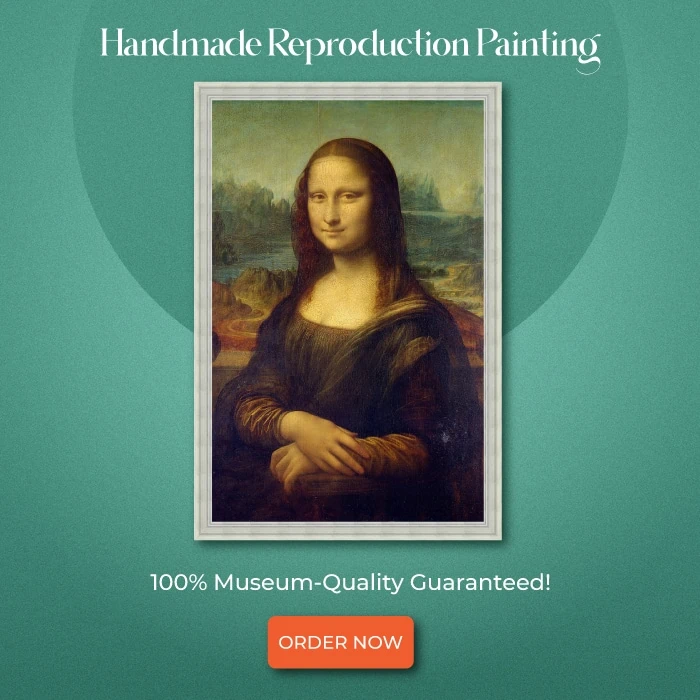Have you ever come across a photo/video of two fingers about to touch? A gesture that has captivated the interest of netizens with its symbolism and aesthetics.
Rings a bell?
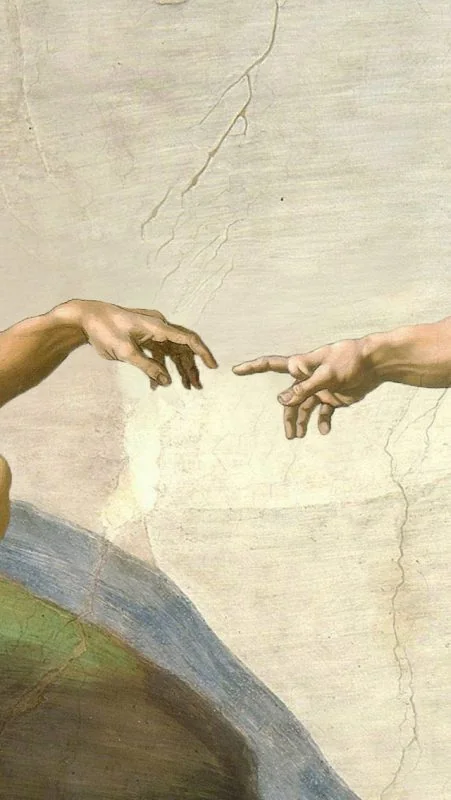
Now does it ring a bell?
Well, for those of you who hardly know, this is the most iconic painting in the European history of art. So much so that the world is going frenzy creating Creation of Adam reproductions in every form.
It has been ruling the ceilings of the Sistine Chapel for decades and is painted by one of the famous Renaissance artists, Michelangelo Buonarroti.
Known to be commissioned by Pope Julius II, the Creation of Man [Adam] was a part of the larger frescoes in the Chapel. It was painted in celebration of God and remains a magnificent display of Man-God dynamics.
Despite being located near the Creation of Eve and Congregation of the Water in the ceiling of the Sistine Chapel, the painting is the first focus of any viewer.
The intricate details that Michelangelo puts into creating the masterpiece show his skill in depicting the divine.
The buzz that the painting has created, and its all-encompassing significance regenerates one’s belief in transformative art.
One of the most famous landscape paintings, the Creation of Adam continues to inspire uncountable works of art and has truly been able to capture the essence of the Renaissance movement.
On the ulterior, it may look like a regular biblical painting of Almighty God touching Adam and breathing life into the first man on earth, but this painting holds more than the eyes can see.
Table of contents
Socio-Historical Significance
The Sistine Chapel has a massive significance in the religious context for its frescoes with the Creation of Adam being the most important of all.
This God and Adam painting is an inspiration with prominent references to the biblical story from the book of Genesis.

The Renaissance period, of all, saw a massive creative, artistic, and cultural change in the European countries.
The Renaissance man showed a rekindled interest in the classics of Greek and Roman culture with a strict rejection of the feudal structures that were dominant during the Dark Ages.
It was also a period of invention, experimentation, and innovation with thinkers pushing themselves to the edge of artistic, scientific, and philosophical creation.
Leonardo Da Vinci’s paintings and other artists like Caravaggio and Botticelli were associated with the masterpieces of the Renaissance.
Yet, the Creation of Man was regarded for its qualities beyond appearance.
A painting taken from Verse 1:27 of the Book of Genesis had to be religiously rich with symbolisms that made it an emblem of faith and devotion among Christians.
Not only did it have a lasting impact on the believers of the world, but it also inspired generations of artistic movements like Baroque and Mannerism.
Considered a high renaissance art, Creation of Adam is also an enduring cultural icon of human creative potential.
The significance of this painting touching fingers extends beyond the realms of art as it reflects the Renaissance idea of humanism and has played a role in shaping the cultural and intellectual history of Western civilization.
Also Read: About Composition VII by Wassily Kandinsky
Theories
The creation of Adam is a striking image of God as a dominant, breathing life into the weak Adam with just an index finger.
While it has taken the entire art world by storm, it has also been studied and debated by theorists.
One of the first theories that intrigued me was that the Creation of Adam portrayed the human brain.
Anatomical Depiction of the Human Brain
The theories suggest that Michelangelo in his painting of God and Adam may have intentionally painted God’s figure in the shape of the scientific human brain.
Some say that being a Renaissance Man, Michelangelo did not let go of the scientific aspect and the shape was an attempt to show the relationship between the mind and the divine.
There is an uncanny similarity between the outline of God’s figure and the shape of a brain.
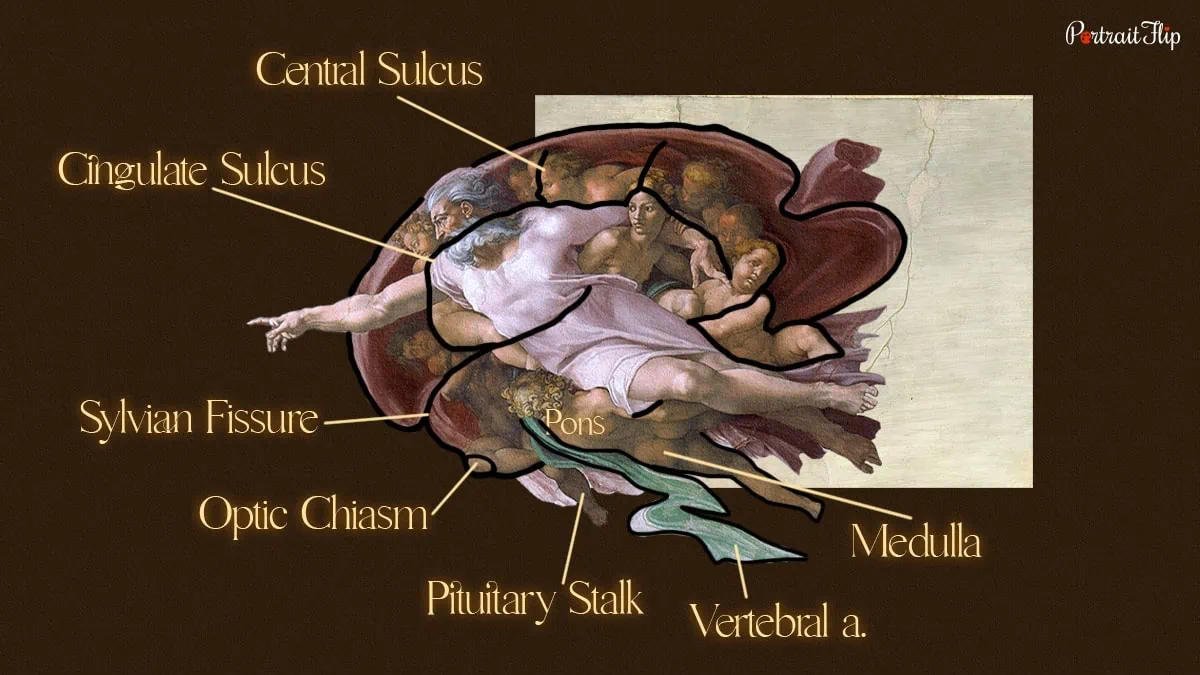
In fact, the folds on God’s robe with a distinct contour resemble the cerebellum that controls motor functions.
The arm reaches Adam through the prefrontal cortex, the area of the brain that deals with creativity.
The position of God’s torso creates an image that evokes the cerebral cortex, the region responsible for cognitive processes like language and memory.
The different sections of the fresco painting of fingers touching, along with the anatomic and neurological matches, Meshberger (the theorist), could certainly say that the figure of God was in fact compatible with the human brain.
Michelangelo believed in the creative power of his mind and stated that the divine guidance came through the intellect which was ultimately the gift of God.
He also concluded that the hidden message that the artist was trying to allude to is that God bestowed Adam with the gift of intellect and only by using this gift to its highest potential will a human be able to create.
The human mind is the manifestation of the divine. Michelangelo’s passion for anatomy and science can be one of the reasons for these theories.
Not all scholars believe this theory and have their own interpretations of the painting.
However, the intentional depiction of the brain in the Creation of Adam remains one of the most captivating theories to date.
Reclining Male Nude: A Study
One of the other theories that surround Michelangelo’s Creation of Adam is the depiction of the naked male in a reclining position.

According to some theorists, the position of God’s arms and Adam’s body create a reclining figure and this has been arguably one of the biggest controversies of art.
However, some propose that the use of the naked male Adam was done for religious significance.
Michelangelo was largely influenced by Greek and Roman art which could have led him to adopt their way of depicting male nude in heroic and idealized poses.
The idea could not have been sexual or erotic especially because the Creation of Adam was being painted on the wall of the Sistine Chapel.
I would personally like to believe the fact that it was Michelangelo’s attempt into creating an Adam close to the Holy Bible. The first man is in a more vulnerable state almost waiting to be touched by God, making his reliance on the divine prominent.
But are any of these theories true?
One couldn’t know.
Despite the theories around the Creation of Adam, it remains one of the most iconic and celebrated works of art in history, a masterful representation of the spiritual and artistic ideals of the Renaissance era.
Themes and Symbols
The Creation of Adam painting lies among the Central paintings of the Sistine Chapel along with other paintings from the Bible’s Book of Genesis. The paintings are to be viewed starting from the altar to the Eastern side of the Chapel.
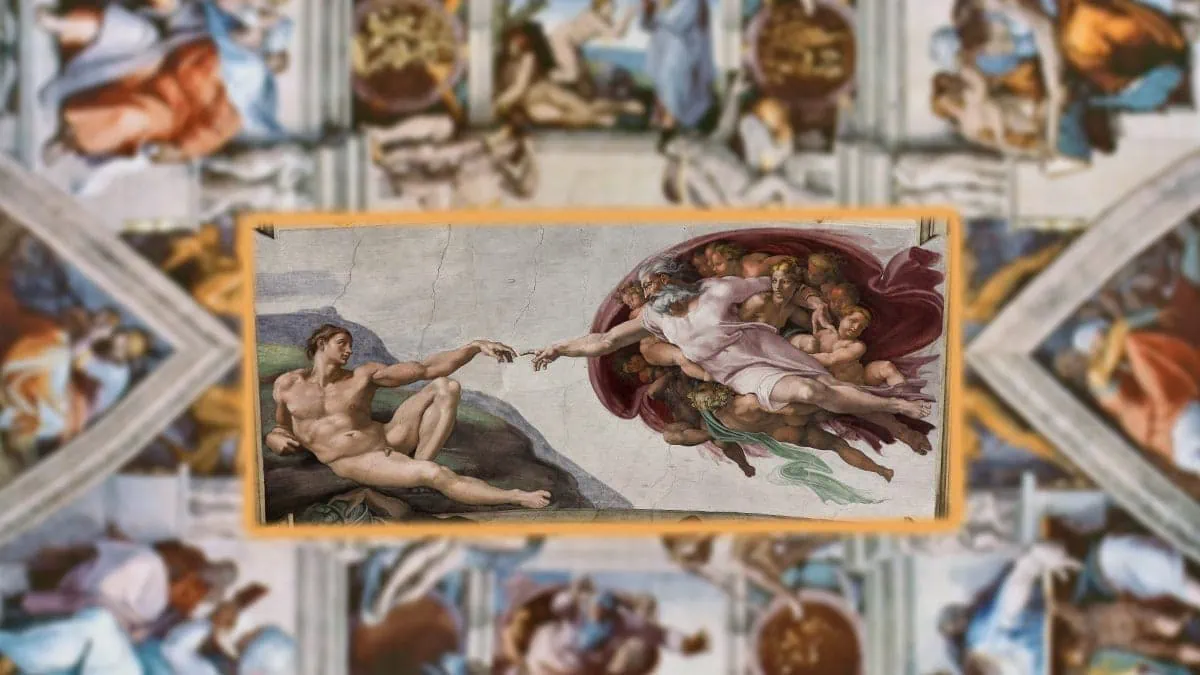
The painting starts with the first three scenes about the creation of the heavens and earth.
Let there be light, sun, moon, and plants, to be precise.
The Separation of Light from Darkness, The Creation of the Sun, Moon, and Plants, and The Separation of Land from the Sea – are the main paintings that guide you to the Creation of Adam.
But we’ll stick to God and Adam for this blog.
Known as one of the most thoughtful paintings ever, what is it exactly about the Creation of Man that has taken the entire world with awe?
It was after all Adam’s creation, the first ever human to be designed on the face of the earth. Not just that, but the painting is filled with thematic and symbolic richness.
The themes of the painting including the God’s finger touching Adam reflect a human-divine connection and have significantly impacted the art community, world, and religious belief for generations.
As much as the painting is full of intricacies and details, it is also filled with meanings and revelations of the biblical stories from the book of Genesis.
Adam – The First Man

The first impression of the painting shows a muscular, naked man in a lounging position. This man is Adam, almost low on energy despite the build.
Brown hair makes him look young with eyes that long. His fingers are almost drooping with no energy awaiting God to breathe life into him.
The use of colors like Green and Blue indicated that the Creation of Plants and Sky has already been completed.
But there is more to the First Man, Adam than what I just described.
Ascanio Condivi, a biographer, explained that God, in order to help Adam, conveyed the Ten Commandments to him before parting.
This notion puts the birth of Adam painting in a similar father-son appearance, making Adam not only the receiver of the energy but also the last-minute advice on how to distinguish between friends and foes.
Interesting, isn’t it?
But what’s more interesting is the character of the father, i.e., the God.
God – The Creator
Positioned diagonally in the top right corner of the painting is God, emerging from the heavens with angels. But are they angels? Keep reading and you will know.
Not only does he look powerful at one glance but also has a sense of dominance attached to him.
God is portrayed as an old, bearded man, muscular and enveloped in a swirling cloak. His right arm extended, with his finger reaching out to Adam with the intention of breathing life into him.
The figure of God is with sharp contours and vibrant shades making him appear bigger than nature.
Behind God, there are 12 figures, nude, youthful, and almost angelic. It seems like these figures are holding God back almost like saving him from being trapped on Earth.
However, upon a closer look, it seems that his body is just floating in the air with one of his arms around the shoulders of the figure behind God.
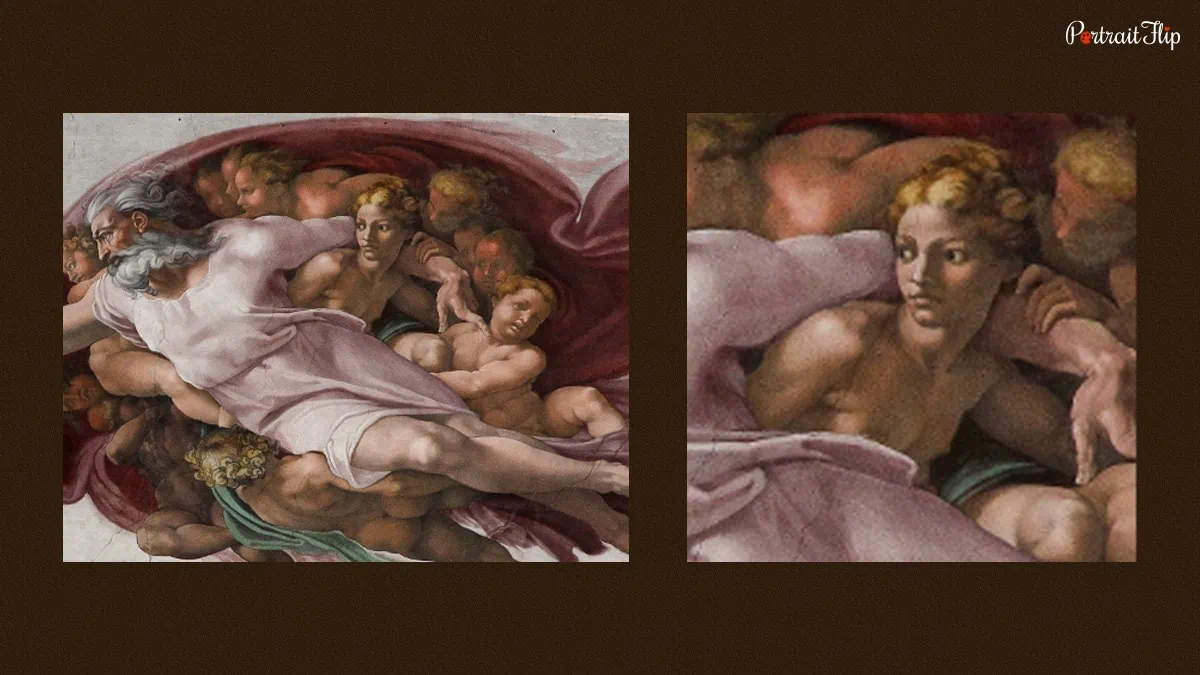
There has been an ongoing scholarly debate on whether the figure is a male or a female. Some think she might be Virgin Mary while others believe her to be Eve.
Can be Eve, considering this is inside God’s mind. She might be just hanging there before she emerges out of Adam’s ribs.
Unsure and not wanting to hurt anybody’s feelings, we’ll just go gender-neutral for this one.
God’s look seems confident as he stretches his arms out to reach Adam.
We all know the brain theory, but while we are trying to read between the lines, what seems like a brain may also be a representation of the uterus.
The red cloth, shaped like a human womb, with the colored green scarf hanging out signifying a newly cut umbilical cord.
Was it then Michelangelo’s representation of the human brain or the uterus? Either way, the painting makes us want to believe that he was indeed a Renaissance Man.
But things don’t end until we point fingers.
Outstretched Hands and Almost Touching Fingers
Michelangelo didn’t leave any stones unturned to weave a variety of symbols into depicting the process of creation.
The outstretched arms of both the subjects with their index fingers touching are caught in motion.

The idea of stopping the act at such a crucial moment is in itself a symbol of showing the process of creation.
It is further emphasized by the contrasting postures of God and Adam that indicate the transformative power of the act of creation as well as the idea that all life springs from a divine source.
Michelangelo’s deeper understanding of both Christian theology and Classical philosophy allowed him to include the idea of free will.
The figure of Adam is shown with his arm extended toward God, although almost out of energy, the gesture suggests his desire for a relationship with the creator.
Despite being absolutely ignorant about his role and expectation as Adam, he still insists to be touched by the incoming index finger.
The painting makes Adam look unaware with his hands innocently extended without any idea of what is about to happen next.
This emphasizes the importance of human agency and free will in the process of creation, highlighting the idea that humanity is an active participant in the unfolding of God’s plan.
Michelangelo’s Compositional Artistry
The formation of a man, a universal happening, illustrated through the Creation of Adam by Michelangelo appears flesh and blood. However, what most people miss out on is to eye its composition.
There is a sense of abstraction in the Creation of Adam’s composition. The art of abstraction lies in its continuity. It very simply puts in our subconscious mind that we are aware of the creation and the powers of the Creator.
The God and Adam painting analysis reveals a rich array of visual cues and folklore that depicts the painting’s symbolic depth.
The main subjects of the painting, God and Adam, are shown in divine communion. Their fingers are frozen in time – as if the touch will explode the universe.
The details of each freckle and the intricate anatomical details speak of Michelangelo’s compositional skills. To create an otherworldly effect, the artist has made use of colors that create majesty.
The creation of Adam is entirely based on the verse.
“So God created man, in His own image; in the image of God, He created him; male and female He created them.”
This pretty much sums up the secret behind Adam painting’s compositional secret.
Let’s take a look at each element and its compositional matter.
But before we move ahead, I’d like to give you a quick look at something.
Check out the left side of Adam’s torso:

One of the biggest pieces of evidence of Michelangelo’s compositional artistry is this extra concealed rib.
Due to Michelangelo’s in-depth knowledge of human anatomy, he insinuated that this rib outline is intentional, and represents the Rib of Eve.
According to the Holy Bible, Eve took birth from the rib of Adam. Pretty much what Michelangelo was probably hinting at.
Moving further, let’s start with the composition of the Almighty.
God, The Almighty
God’s dominating presence in The Creation of Adam shows his power and importance in the painting. The muscular being with flowing robes and commanding presence makes a strong statement about him.

His facial features with grey hair and beard also suggest him to be an older and wiser man. Along with him are 12 youthful characters who happen to be the characters from his brain.
The figure of God is composed at a diagonal angle. He does not appear to be leaning on anything but just floating seamlessly.
With his arms stretched out, God is looking at Adam who is situated slightly below, with power.
The image of God, like the verse in the book of Genesis, is a counterpart of the image of Adam. Both looked absolutely alike with the only difference being that one was authority and the other a mere follower.
Michelangelo’s depiction of God may be largely inspired by the medieval hymn “Veni Creator Spiritus.” It literally translates to “finger of the paternal right hand.”
The composition of God in the Creation of Adam is surrounded by divided opinions
Nevertheless, it is universally recognized as a symbol of religious faith and artistic mastery, a testament to the enduring power of Michelangelo’s vision and his ability to transcend time and space with his artistic genius.
Adam, The Creation
Adam, another important subject and the main creation of God, also reflects the mastery of Michelangelo and his understanding of human form.

A young, idealized man, with absolutely flawless and soft sensual expression, is the creation of God.
His form appears to be bathed in a golden glow, and saying that he is a divine creation would be an understatement. However, his outstretched arm and open hand create a sense of vulnerability and longing.
As if he is almost yearning to be touched by God and brought to life.
The anatomical expression of Adam is impressive, with every muscle and curve rendered in exquisite detail. Despite the details, the body looks smooth and otherworldly.
Symbolically, Adam represents the first man, the beginning of humanity, and is an embodiment of God’s creative power.
Although the overall appearance of Adam is beautiful, his twisted torso depicts that he is still spiritually incomplete.
Everything from his posture to his expressions depicts an amateur being. The innocence and wonder, upon being created by just a thought of the Almighty reflects an awe-inspiring moment of creation.
The Outstretched Arms
Yes, we keep coming back to the outstretched arms. It is precisely because this particular section creates a lot of anxiety in the viewers.
The way Michelangelo left the painting has created an overwhelming feeling in the viewers.
The hands depicted by the great artist are particularly noteworthy. It has become one of the most talked about elements in art.

The hands of God are carefully rendered with defined muscles, tendons, and veins that give a sense of authority and strength.
On the contrary, Adam’s hand is less defined with a weak body conveying vulnerability and humility.
However, the dramatic play of light and shadow on both hands creates depth and texture. It creates a natural focus on the hands and adds to the relationship between humanity and divinity.
One of the most celebrated paintings of God touching Adam, and it symbolizes the connection between morality and life.
This painting is also considered one of the oldest still-life paintings.
Regardless of the compositional artistry of the Creation of Adam, the painting has had an enduring impact. It continues to inspire people and has been a part of countless art memes.
The Balance
There is a compositional balance created in God’s and Adam’s position in the painting. Their placements divide the composition into two parts – the “Concave” Adam and the “Convex” God.
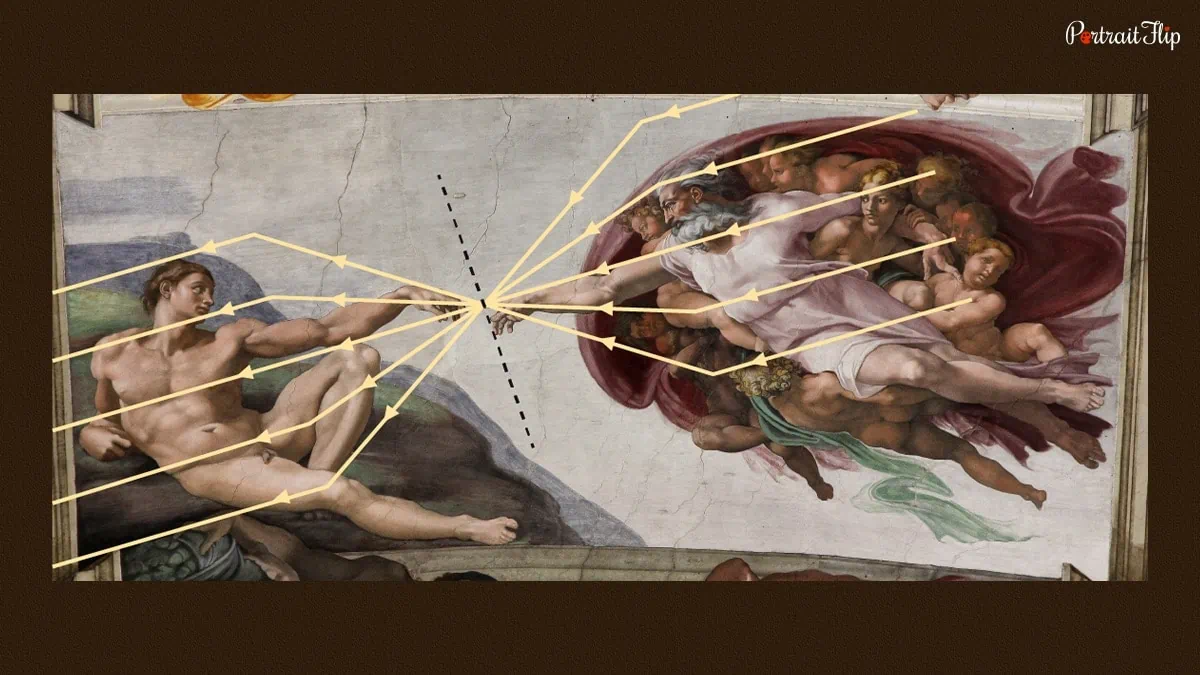
Even the backdrop behind both figures is dominantly curved shapes. It is contrasted by the strong horizontal line created by the outstretched arms. The culminating hands of God and Adam seemingly connect both parts.
There is a balance in the composition due to the positioning and the depiction. This forms a perfect contrast between the two and hints at the deeper meaning and relationship between God and Adam.
Light and Color

The colors in The Creation of Adam are integral to the overall impact and emotional appeal of the painting.
The use of light and shadow across the details of the figures adds a sense of depth and dimensionality to the action.
Light is particularly powerful as a light source illuminates the figures from the left creating contrast and drama.
The contrast helps in separating between humanity and divinity adding tension to the scene.
The color scheme on the other hand elevates the experience of the painting. Fleshy tones like browns and creams as well as yellows are used. Darker areas of shading on the figures create depth, emphasizing their shapes and anatomy.
Additionally, the colors add to the emotional impact of the painting, with the warm, earthy tones of Adam’s body evoking a sense of physicality and the cool, ethereal tones of God’s figure conveying a sense of spiritual transcendence.

Other colors that happen to stand out but do not attempt to overpower the painting are the colors used in the background.
The greens of the grass, the blues of the sky, and the reds of the scarf – the cooler and the warmer shades create a contrasting effect and a different color value compared to the lighter value of the figures.
While the rest of the frescoes remain, a neutral white color makes the two primary figures, God and Adam stand out in the entire painting.
Although the white color was a go-to for all frescoes making them look like a part of the same theme, it can also be interpreted as the clouds.
Michelangelo, a skilled artist, added an undertone to the symbolism of the painting with the use of colors.
Appearance

The appearance of the characters looks smooth with an implied texture used for the drapery and clothing.
The skin textures are smooth, some have plump flesh while others look muscularly taught. The hair, especially for God, appears soft and flowing towards the right of the composition due to an unknown breeze or wind.
But what is the most interesting aspect of the painting is the position in which God and Adam are placed. They are placed diagonally, showing the transmission of energy from the maker to a creature.
Furthermore, observing the bridge of the arm, one can see the connection between two separate worlds – the compact compactness of God’s mantle, given forward motion by the diagonal of his body, and the incomplete, flat shape of the earth, whose passivity is shown by its backward contour.
Reception
Many can attest to the immense impact that the painting The Creation of Adm had on the world from when it was first unveiled.
The painting was a Renaissance masterpiece and garnered attention as an acclaimed art from enthusiasts and scholars equally.
The intricate detailing and skillful techniques displayed in the painting left viewers in awe, and it quickly became one of the most famous and revered works in the history of art.
The creation of Adam was not only lauded for its beauty and complexity but it was also criticized by a few. Nonetheless, the overall reception was welcoming.
The painting’s exploration of themes such as humanity, divinity, and the nature of creation resonated with the faiths of people irrespective of their culture and belief. After all, every culture believed that God was the creator of humans. What Michelangelo did was, paint the process of giving life, making it a universal masterpiece that has stood the test of time.
Influence

Michelangelo’s painting touching fingers has had a profound influence on the art community in particular and the world at large.
As one of the most recognizable and celebrated works of art in history, it has come to represent the pinnacle of an artist’s achievement, a testament to the power of creativity and inspiration.
The Creation of Adam has not only inspired countless artists over the centuries but also has had a significant impact on popular culture.
From serving as a touchstone for the development of new painting styles and techniques to becoming iconic imagery appearing in advertisements and fashion, this painting has reached a different level of success.
Its enduring popularity and ubiquity attest to the universality of its message and its ability to resonate with people of all backgrounds and beliefs.
The painting of God and Adam has played a central role in shaping religious beliefs and practices, particularly within the Christian tradition. It has become a powerful symbol of the divine and a source of inspiration and comfort for many people around the world.
It has helped to reinforce and strengthen the role of art and creativity in religious expression and worship emphasizing the importance of beauty, imagination, and inspiration in our spiritual lives.
In alternative ways, God’s hand painting gives us an assurance that despite having free will, it is God after all, who gives us the energy and holds our hands as we move forward.
The Creation of Adam represents the culmination of the artistic and cultural ideals of the Renaissance era, a celebration of the human spirit and its connection to the divine.
Its influence can be seen in the art and culture of subsequent centuries, as well as in the ongoing efforts to create new works of art that speak to the deepest aspirations of the human soul.
As an expert in the field of art history, I can attest to the timeless appeal of The Creation of Adam even today.
It continues to captivate viewers with its powerful portrayal of the creation of humanity.
Closing Facts
A few closing facts about The Creation of Adam so that you leave on as interesting a note as you started with.
- Michelangelo was commissioned to paint the twelve apostles and he worked at the Pope’s tomb for 40 years.
- Michelangelo was reluctant to take up the job because he considered himself a sculptor and not a painter.
- The Creation of Adam is a part of 500-sq. meter fresco.
- The Creation of Adam is at the center of the ceiling.
- Michelangelo actually painted it while being able to lie down with the help of a specific type of scaffolding.
- The image of God was the last figure that Michelangelo painted on the entire ceiling as he wanted to make it perfect.
- Apart from The Last Supper Replica, The Creation of Adam is one of the most reproduced religious paintings in the world.
While there is no end to the number of facts that surround this vast and magnificent painting, I think I have taken enough of your time. I am pretty sure that I was able to answer every question associated with the painting.
A few of what is left will definitely be included in the Frequently Asked Questions below.
It is a pleasure to reflect on the ongoing legacy of this masterpiece and how it continues to inspire and move us.
Author Speaks
Dear Readers,
I hope you enjoyed reading our blog on The Creation of Adam, a true masterpiece.
If you found this article enlightening, I encourage you to explore our blog page where we write captivating content on art and culture.
Additionally, we invite you to follow us on Instagram and subscribe to our YouTube where you can stay updated on our latest endeavors.
If you have any information to add or comments that you would like to leave, please feel free to comment below or write to me at [email protected].
We at PortraitFlip are passionate about sharing our knowledge and expertise on art, and we hope to continue to provide engaging content for you.
Thank you for reading, and we look forward to sharing more with you soon.
Cheers.
Frequently Asked Questions
Estimated prices would be millions of dollars, but because it is also part of the Sistine Chapel, it could be priceless. However, you can always buy a replica.
Creation of Adam was painted between 1508-1512 on the ceiling of Sistine Chapel.
The painting is a prime example of High Renaissance art, which was characterized by a focus on realism, balance, and harmony.
While the exact amount of time is not known, it is estimated that Michelangelo took approximately 4 years to complete the entire ceiling of the Sistine Chapel, including the Creation of Adam.
The Creation of Adam is famous because it depicts an important religious moment in the teachings of Christianity. The painting capture the scene when God breathed life into Adam, the first man.



